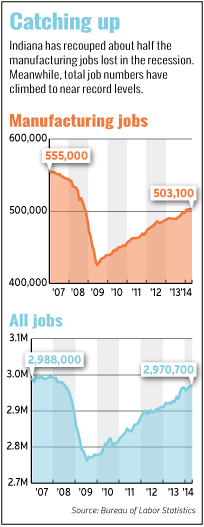Subscriber Benefit
As a subscriber you can listen to articles at work, in the car, or while you work out. Subscribe NowBy any measure but one, Indiana’s manufacturing sector bounced back strongly from the recession.
In the past year, the state led the nation in manufacturing job growth and ranked sixth in rate of growth (2.7 percent). Indiana has also added the second-most manufacturing jobs (75,200) in the United States since July 2009, the state’s period of peak unemployment. And Indiana continues to lead the nation in manufacturing jobs as a portion of private-sector employment, 16.9 percent.
 About the only metric that still looks anemic is the number of Hoosiers actually employed to make things. The recession forced companies to replace people with technology.
About the only metric that still looks anemic is the number of Hoosiers actually employed to make things. The recession forced companies to replace people with technology.
These efficient manufacturers would have to grow significantly in order to need a lot more workers, and that hasn’t happened.
“From April of 2004 to April of 2014, we are still down about 67,000 manufacturing jobs,” says Brian Burton, vice president of the Indiana Manufacturers Association.
The reason, according to Mike Hicks, professor of economics and director of the Center for Business and Economic Research at Ball State University, is that hiring in such a capital-intensive field always lags production increases. And the rapid growth in worker productivity Indiana saw during the post-recession years also means fewer workers need apply. But at least that favorite news show straw man, off-shoring, isn’t to blame.
“Almost all the job losses nationwide in manufacturing are due to productivity growth,” Hicks said. “The highest estimates of job losses due to off-shoring is about 5 percent of all jobs. Employment growth in manufacturing has slowed because we are very good at manufacturing, not because of foreign competition.”
In other words, fewer Hoosiers are needed to make widgets because it takes fewer people to make widgets. But Burton thinks Indiana will still enjoy a steady uptick in factory jobs, mostly because more manufacturers will come here to take advantage of the state’s low taxes, business-friendly regulations and central location.
“I think you’ll see an expansion in manufacturing jobs,” he said. “We’ve made tremendous advances in our tax structure and our overall business climate. Plus, we’re in a prime geographic location with the logistics infrastructure the manufacturing sector needs.”
Many of those jobs won’t be done in the stereotypical smoke-belching, big-as-a-barn factories of yore. Hicks says the state is seeing an influx of smaller facilities with leaner, more flexible staffing.
“If you were to go into a modern manufacturing facility today, you would not recognize it from a few decades ago,” Burton added. “It is automated, it is highly technical, it is clean, it is efficient. It is a marvel.”
There’s a worry, however, that Indiana might not graduate enough efficient, highly technical workers to staff those facilities. Especially given Hicks’ observation that perhaps one in six Hoosier factory workers is at retirement age right now, opening up a historically large number of positions in the next decade. Finding enough qualified workers to replace them could be a challenge. A challenge that state, county and city agencies are struggling to meet.
“There’s a tremendous amount of effort being put into place right now with the governor’s current jobs council, and also work councils around the state, to address those needs,” Burton said.
Making sure Indiana remains a manufacturing leader could be vital for the future of the state—a state with a gross domestic product roughly equal to Taiwan’s. In 2012, manufacturing accounted for an enormous $84.1 billion, or 28.4 percent, of the gross state product. Government’s $28.8 billion contribution was only good for a distant second, and the entire agriculture sector generated a paltry $3.9 billion.
Perhaps of more interest to the rank and file, in 2012 manufacturing handed out $28.3 billion in wages and salaries, with government coming in second at $17.4 billion.
When it comes to both GDP contribution and paychecks, smokestack industries are still the biggest bars on the bar graphs. The trick is to keep it that way.
“If the big tower falls, it wipes out everything,” Burton said.•
Please enable JavaScript to view this content.
